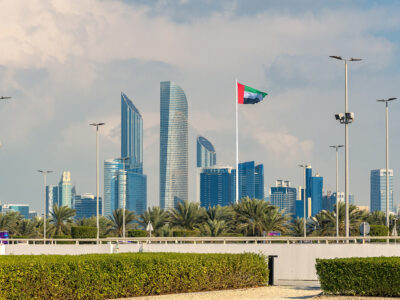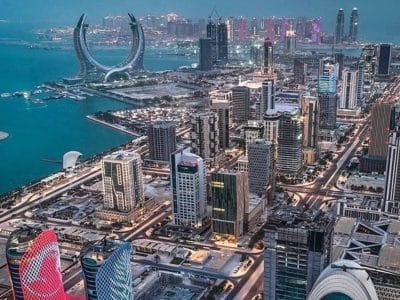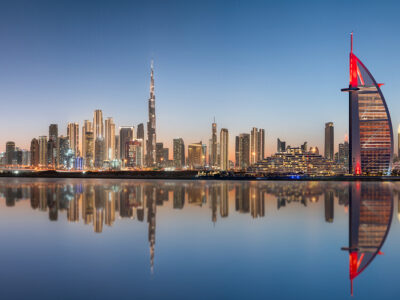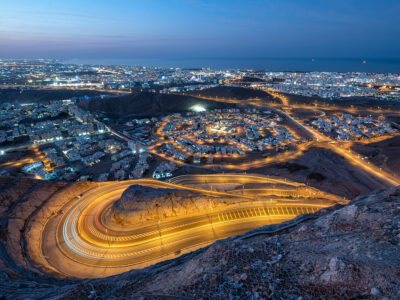I’m hearing this from you! I’ve never heard this before,” laughs Mubarak Al Muhairi. “It’s very exciting that Abu Dhabi will have its own Grand Prix, isn’t it?” I try to pry more information from him, but the director general of Abu Dhabi Tourism Authority (ADTA) just smiles and shakes his head.
A few days later, at the Abu Dhabi F1 festival, it is announced in front of an elated crowd of 15,000 people that the UAE’s capital has signed a seven-year contract to host a world championship Grand Prix on Yas Island from 2009.
“One of our main criteria when we are deciding what events to stage is the media impact of the event in creating awareness of Abu Dhabi.
All our studies have proven that sport is the number one attraction,” Al Muhairi explains.
The F1 festival featured the largest gathering of current Formula One drivers and cars ever assembled outside of a Grand Prix, something the ADTA chief is very proud of, so what better way to tell the world that the capital has secured one of the globe’s most prestigious sporting events?
Abu Dhabi has built up an impressive portfolio of sporting events and these have played a crucial role in generating international awareness of the emirate. Since 2005, the emirate has hosted the annual Red Bull Air Race, part of an international series of ‘aircraft F1′ racing, while at the end of last year ADTA announced that the capital city would play host to the ‘Cycling Race of Champions’ in November 2007.
The winners and the teams of the three most prestigious cycling races in France, Spain and Italy will pedal furiously around Abu Dhabi to compete alongside three wildcard teams for a US$1m prize – a far greater sum than any other cycling race, even the Tour de France, has ever seen.
“This has generated a lot of attention as it’s the first event of its kind and it’s happening in the Middle East. The race will cover a lot of the geographical area of Abu Dhabi so it’s great publicity for us,” says Al Muhairi.
All these sporting events combined, says Al Muhairi, enable the Abu Dhabi name to be spread around the world via extensive television and media coverage. However they also bring the world to Abu Dhabi with an international line-up of competitors and regional and local spectators, boosting its chances of drawing in three million tourists by 2015.
Consequently, Abu Dhabi’s hotel occupancy rates have shot up in the last few years.
“Back in 2004, when we were presenting our plans to private hotel companies, it was difficult to sell it to them because they’d look at the numbers and say ‘60% occupancy?
Why would we want to invest or expand here?'”
“Last year our occupancy rates were 84% – one of the highest in the region, or even the world, and now we have a lineup of investors waiting for opportunities and land.
All the big exclusive brands and resorts want to come here,” he adds with a clear sense of pride.
Al Muhairi has every reason to be proud. Since being appointed director general of the ADTA on its creation in September 2004, he has worked closely with the authority’s chairman, HH Sheikh Sultan Bin Tahnoon Al Nahyan, and has had wide-ranging responsibilities for the body’s promotion, development, regulation and classification of the emirate’s tourism sector.
Angsana Resorts & Spa is one international business that has spotted the emirate’s potential and is developing a US$110m eco-spa site that will transform 140,000 sq m of land in Abu Dhabi’s Eastern Mangroves District and be fully operational within three years. Angsana will be managed by the recently-launched Tourism Development & Investment Company (TDIC), headed up by CEO Lee Tabler – an independent public joint stock company charged with handling the tourism investment zones of the ADTA and of which Al Muhairi is the managing director.
“We are aiming for the top end of the tourism market and from day one we announced that we are not interested in mass tourism,” says Al Muhairi firmly. This is not to say, however, that the body’s plans are not ambitious. Abu Dhabi is planning to add a massive 70-80 hotels, and around 17,000 hotel rooms, by 2015 in a bid to increase tourism from almost one million in 2004, to more than three million. The ADTA has approved investment packages for 4500 new rooms to be added over the next three years. New hotels being built on Saadiyat Island will considerably boost the emirate’s room inventory and include the recently announced 450-room Rotana beachfront property, expected to open towards the end of 2009 – in time for the launch of the emirate’s own GP race. Along Abu Dhabi’s waterfront, the 35-storey five-star Grand Corniche Hotel is also scheduled to open in late 2009, boasting 349 rooms, 90 suites, 144 serviced apartments and a 3600 sq m shopping arcade.
The Abu Dhabi Tourist Club is currently being redeveloped as a waterfront leisure destination called The Quay, which will include a 620-room five-star hotel, 400 luxury apartments, office space in two 20-storey towers, and a 60-berth marina, while in the short-term, the Shangri-La Hotel Qaryat Al Beri is set to open next month.
Investment in Abu Dhabi’s hospitality sector has soared recently, with the emirate ranked among the world’s top 10 in RevPAR (revenue per available room) growth during the first half of last year, according to a study by international business consultants Deloitte.
Demand, however, is already outstripping supply. The TDIC has imaginatively chartered two cruise ships berthed in Abu Dhabi’s Mina Zayed Free Port until the end of the month. These will serve as floating hotels in order to meet extra demand for accommodation being generated from major conferences – most notably the International Defence Exhibition (IDEX) from February 18-22. “This is an important part of our economic diversification because visitors are not only coming for tourism – they are also coming for business and exhibitions,” explains Al Muhairi.
“Abu Dhabi is a business centre and so it needed its own exhibition centre, hence why the new Abu Dhabi National Exhibition Centre has been created and it has already signed around 40 new business exhibitions.
The centre, currently under construction, will provide 57,000 sq m of space and have dedicated conference facilities for up to 1200 people.
The other word hot on Al Muhairi’s lips right now is culture.
Central to Saadiyat Island, the US$27bn flagship tourism project being developed by the TDIC, is an upscale cultural district comprising five art galleries that will form the centrepiece of the island.
The renowned architect Jean Nouvel is set to build a ‘classical museum’ which could accommodate works from Paris’s world-famous Musee du Louvre, while Zaha Hadid is designing Saadiyat’s performing arts centre which will host music, theatre and dance events.
Saadiyat will also feature a Sheikh Zayed National Museum devoted to the history of Abu Dhabi and its late ruler, HH Sheikh Zayed Bin Sultan al Nahyan. Scheduled for completion in 2011, the US$400m Frank Gehry-designed Guggenheim Abu Dhabi Museum is expected to be the largest of the prestigious Guggenheim museums.
“Abu Dhabi’s ambition is to have a cultural district as the cultural hub for the region and for the world,” says Al Muhairi without batting an eyelid. “We want to create a generation that can recognise, respect and understand art and culture.
We believe art is a universal language that crosses boundaries so we don’t believe we are developing something for just the UAE. I believe its impact will be truly felt on a global scale.
“The cultural district project is huge – it’s the only one of its size and combination – and I don’t see any similar undertaking in art and culture happening anywhere else in the world.
This region has previously been criticised for lacking in art and culture and I think this is a great defence to these critics.”
The museum announcements have also helped to attract foreign investment. “Since the announcement, there has been a sudden interest from international funds and institutions in investing in other aspects such as resorts and hotels.”
I ask Al Muhairi if he thinks that Saadiyat (an island half the size of Bermuda) and Yas Island (the US$40bn development a third of the size of Abu Dhabi City) – are what really sealed Abu Dhabi’s status as an up-and-coming tourist destination.
“You know, these islands have really caught the world’s attention but you simply can’t attribute it to one thing.
It’s a combination of Etihad Airways’ growth, the events being staged in Abu Dhabi, and the work of our overseas offices. We trained around 1000 travel agents in Germany and the UK last year on how to sell Abu Dhabi. So it’s not only about these two islands. It’s a big task that entails a branding awareness of Abu Dhabi.”
Al Muhairi is adamant that the capital should not be viewed as a tourist destination in isolation from other emirates – rather the UAE as a whole should be viewed as a tourist destination.
“Travellers now tend to go to more than one destination on holiday – they stay eight to 12 nights – and it’s difficult to keep them in just one city. We see ourselves complementing what the other emirates have.”
Al Muhairi has not lost sight of the fact, however, that each emirate has its own identity.
“Of course each emirate is differentiating and each one is different. Abu Dhabi makes up around 85% of the UAE’s landmass and is gifted with 200 islands so it has more coastal areas.
“A lot of our tourism projects integrate eco-tourism and we are in the process of turning Sir Bani Yas Island into a large nature reserve.
“I think Abu Dhabi’s tourism will strengthen the UAE’s overall offering.
“2005 and 2006 were the years that we built the trust between us and the private sector that includes investors, operators, travel agents and the media, and 2007 will be all about growth and tangible results, so it is going to be an extremely exciting year,” he concludes.







